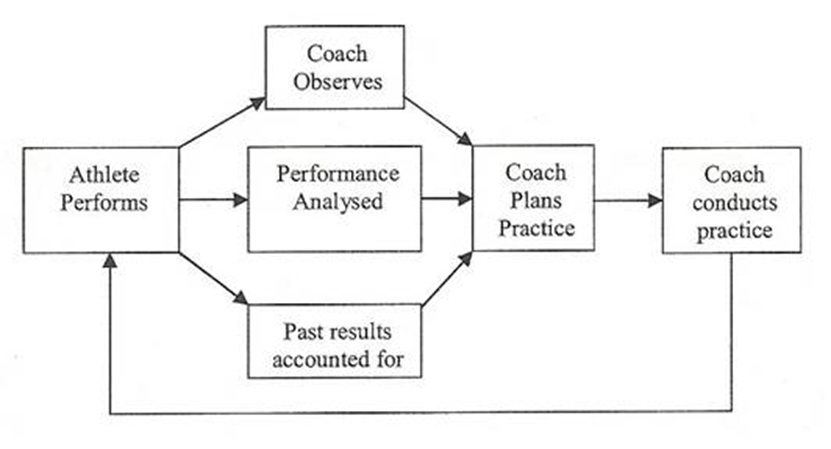An Introduction to the Soccer Coaching Process
Successful coaches have an almost insatiable appetite for knowledge about every facet of the game. The coach’s craft knowledge is developed through playing the game, observing matches and successful mentoring by more experienced coaches (Carling, Williams & Reilly, 2005). Whilst this knowledge is very helpful in developing an extensive library of information relating to successful tactics and strategies, it is nevertheless subjective and potentially confounded by personal biases and expectations (Hughes & Franks, 2004). Quantitative match analysis is therefore invaluable to the coach in that it can help create an objective, unbiased view of events and provide a solid platform upon which to make informed decisions as to successful tactics and strategies. As the match analysis process tends to concentrate on providing information about tactical (e.g. effectiveness of playing style) and technical (e.g. passing success rates) performance, Carling et al. suggest that the process is particularly relevant in understanding performance as well as identifying areas for improvement.
Coaches must carefully plan and organize weekly training programs based on the results gleaned from observational match analysis and with the single aim of providing optimal preparation for competition. The process of successfully devising training sessions which can be transferred into competitive performance is one of the key roles of the coach (Hughes & Franks, 2004). Therefore, it would be beneficial for any coach to devise their coaching sessions and weekly training programs on the basis of actual match performance information provided from manual or computerized match analysis.
The coaching process is comprised of a cycle of phases relating to aspects of observation, analysis and planning (Franks, Goodman & Miller, 1983) (See Figure 1). In essence, the coaching process is used to instigate observable changes in behavior as the coaching and teaching of skills is heavily dependent upon match analysis, which in turn has a positive effect on the overall improvement of athletic performance (Maslovat & Franks, 2008).
Figure 1: The Coaching Process

Source: Franks et al. (1983)
This particular version of the coaching process, however, is not entirely applicable to the recent technological advances in sport.
Inclusion of Computer & Video Technology
In conjunction with the technological advancements and the assistance of computer and video aided technology in sport, Hughes and Franks (2004) have proposed an innovative and ‘modernized’ version of the coaching process (See Figure 2). This Coaching Process (with the Inclusion of Computer & Video Technology) Schema is based on providing a more comprehensive and accurate account of the coaching process undertaken by the sports coaches in the 21st century.
Figure 2: The Coaching Process (with Inclusion of Computer & Video Technology) Schema

Source: Hughes & Franks (2004)
The modified flow-diagram of Hughes and Franks has thus identified and located both performance (notational) analysis and observational video analysis firmly within the coaching process.
Unfortunately, there is currently dearth of empirical research evidence available on match analysis and the tactical development of young football players. Nevertheless, there is a small amount of research literature available which can be used to offer a valuable insight into the use of video match analysis and its contribution to tactical knowledge. Firstly, it is important to gain a clear interpretation of performance analysis.
Performance (Notational) Analysis
Notational analysis is an objective way of recording performance, so that critical events in that performance can be quantified in a consistent and reliable manner (Hughes & Bartlett, 2008). Consequently, identifying the main reasons to explain why certain teams and athletes achieve sporting success has unquestionably become one of the most desired and widespread primary objectives identified within the current research literature of sports performance (Hughes, 2007). Most of the methodological approaches used within the current literature of sports performance have been formulated to assess and evaluate a range of the most successful (and unsuccessful) actions for both teams and individual athletes. Hughes and Franks (2004) suggest that the outcomes of these methodological approaches provide a vast array of statistical data based on the discrete actions performed by both teams and players during sporting performance – primarily through the use of observational video analysis.
Observational Video Analysis
Observational video analysis software aims to provide accurate feedback to coaches and competitors with of a goal of identifying aspects of technique that require improvement and/or to enhance overall performance (Hughes & Franks, 2004). It is a dynamic tool which provides invaluable ‘real-time’ and ‘post-game’ analysis capabilities by extracting specific and relevant aspects of performance (e.g. number of touches, shots at goal etc). The video footage of competition and training allows the movements and actions of players to be recorded, observed, analyzed and evaluated and thus provides quantitative information on playing performance. Moreover, Elite Sports Analysis (2007) claims that observational video analysis is therefore a vital domain of sports research as it can inform the coaching process through the provision of accurate and quantitative statistical data.
Contribution to Tactical Knowledge
Traditionally, the performance analysis of football has focused solely on the analysis of movement and different patterns of play throughout the match (Reep & Benjamin, 1968; Reilly & Thomas, 1976; Harris & Reilly, 1988). It is only in more recent times has any form of empirical research attempted to address specific football tactics and principles of play in order to adapt the practice strategy of a team (McCorry, Saunders, O’Donoghue & Murphy, 1996; Hughes & Bartlett, 2002; Hodges & Franks, 2002; Hughes & Franks, 2002). Therefore, the tactical knowledge that emerges from observational video analysis in football remains under construction.
Nonetheless, deciding upon an effective set of tactics to suit a particular team is still highly regarded by some as one of, if not, the most fundamental contributors towards successful sporting performance (Carling, Williams & Reilly, 2005). The rationale for this statement is because Carling et al. firmly believe that, through the collection of valid and reliable objective data, the coach can use observational video analysis to determine the most effective tactics and strategies to employ. The data provides the coach with a solid foundation upon which to base all tactical and strategical decisions.


